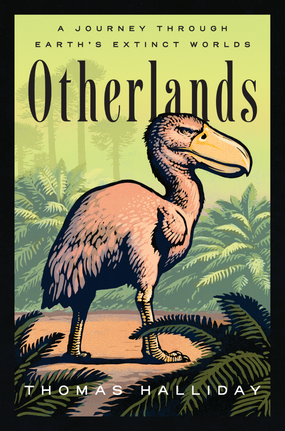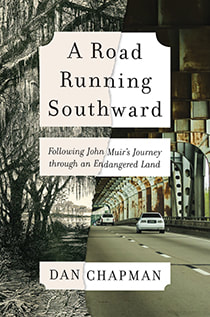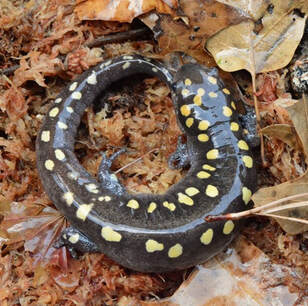 Most of the information and viewpoints found on the Conservation South website focus on issues, opportunities, and resources directly concerned with environmental conservation and restoration in the southern U.S. This book review is different: the topic is a “deep time” perspective. British paleontologist and evolutionary biologist Thomas Halliday has authored Otherlands: Journey in Earth’s Extinct Ecosystems (Penguin Random House, 2022), a fascinating overview of how Earth’s ecosystems and biota have dramatically changed over the long 4-billion-years timeline of life and tectonic forces on our planet. Each of Halliday’s sixteen chapters describes wholesale changes in ecosystems and life forms that have repeatedly occurred throughout eras of Earth history. Earth is now a “human planet,” asserts Halliday, nearly totally affected by we humans. He observes, “The world as it is today is a direct result . . . of what has gone before. Much of life in the past happens in a steady state of slow-changing existence, but there are times when everything can be upended. . . . It is by looking at the past that palaeobiologists, ecologists and climate scientists can address the near- and long-term future of our planet, casting backwards to predict possible futures. Unlike past occasions . . . our (human) species is in an unusual position of control over the outcome (of a fundamentally altered biosphere). We know that change is occurring, we know that we are responsible, we know what will happen if it continues, we know that we can stop it, and we know how. The question is whether we will try.” <continued . . .>
0 Comments
 Dan Chapman, veteran journalist, conservationist, and writer for the Atlanta Journal-Constitution, Charlotte Observer, Winston-Salem Journal, Congressional Quarterly, and the US Fish and Wildlife Service, has authored a fascinating new book. A Road Running Southward: Following John Muir’s Journey through an Endangered Land (Island Press, 2022) blends biography with an accounting of Muir’s observations in his 1867 post-war, thousand-mile transect of the American South. Chapman’s book spells out Muir’s personal awakening to threats to the natural environment, and offers a critical assessment of today’s perils to environmental resources in the southern U.S. As some may recall, I authored my own account of “John Muir’s Southern Trek, 150 Years Later” in the sesquicentennial year of Muir’s southern adventure. My perspective differs from that presented by Chapman. Because my professional career has been in land and environmental conservation, the focus of my account was to identify the many places along Muir’s route where natural areas and native biota have been protected through the efforts of conservationists, and where one today can observe and imagine the natural scenes and biodiversity that Muir would have seen in his trek across the American South. Like Chapman, my vehicle for following Muir’s route was also my trustworthy old Subaru. <continued...> Walt Kelly's satirical cartoon from the 1970s has a certain appeal at this time. We share below the image of a 1980 reprint of Kelly's 1970 poster, “We Have Met the Enemy…” From the Toni Mendez Collection, at The Ohio State University, Billy Ireland Cartoon Library & Museum.
Southern Conservation Partners shares the concerns expressed by many friends and defenders of the forest ecosystems of the southern U.S., which are currently being exploited and threatened by mass removal for export as wood pellet biofuels principally in Europe. Many of the forests being cut are already imperiled river bottomlands forests ecosystems that are critically necessary for sustenance of the environmental health of the southern U.S. region.The biofuel producing companies are “green washing” their activities and propaganda based on intentionally false and deceptive claims that cutting and burning trees on a mass scale is “carbon neutral” because the forests may regrow sometime in the long-term future and hence forests are a “renewable” resource. Most of the processing plants that collect, chip, and process cut trees in huge volumes for export are located in marginalized, economically distressed communities, and those industrial plants are operating at full capacity 24/7 and emitting huge quantities of airborne pollutants. The Southern Environmental Law Center, the Dogwood Alliance, and the National Wildlife Federation are leading defense actions to save our forests.
We recommend you watch this 30-minute documentary film: Burned: Are Trees the New Coal? In addition, the North Carolina Wildlife Federation and its coastal Island Wildlife Chapter recently presented an excellent, profoundly important webinar about this crisis. VIEW the recording of that webinar. Several other resources on this important issue: Wood Pellet Map Carbon Markets Article--How Marginalized Communities in the South are Paying the Price for “Green Energy” in Europe Forests are vital elements to our nation’s infrastructure and environmental health. Strong climate action rooted in justice has never been more urgent. Valuing standing forests is our best climate defense! Take the “Stand 4 Forests Pledge” HERE. The following is excerpted from a National Geographic magazine essay (Sept. 2020 issue) and from Enric Sala’s book, The Nature of Nature: Why We Need the Wild (2020). (Britain’s Prince Charles and Harvard biologist E.O. Wilson furnish the book’s introductions.)
“If we degrade habitats, animals become stressed and shed more viruses. On the other hand, habitats with diverse species harbor less disease. . . . Nature controls viruses – filtering them out of the system – that we’re only now recognizing. . . . "We are all in this together, all species on the planet. So what can we do? While the world has stepped up to help those in need during the COVID-19 outbreaks, we might also start thinking about how to prevent the next zoonotic pandemic. "We have seen, again and again, that even though we don’t know what most of them do, all wild animals have important jobs that keep our biosphere running. If we’ve learned anything from our study of natural ecosystems as it applies to these recent diseases, it’s that instead of exterminating wild animals to stop the passage of disease to people, we should do the opposite: We should safeguard the natural ecosystems that are their homes and, if needed, help set them back on their path to maturity through rewilding. "If we degrade habitats, animals become stressed and shed more viruses. On the other hand, habitats with diverse microbial, plant, and animal species harbor less disease. Biodiversity dilutes any viruses that emerge and provides a natural shield that absorbs the fallout from pathogens. "Clamping down on the illegal trade of wildlife, ending deforestation, protecting intact ecosystems, educating people about the risks of consuming wildlife, changing the way we produce food, phasing out fossil fuels, and transitioning to a circular economy: these are the things we can and must do. "Even if it’s just for selfish reasons—for our own survival—now more than ever, we need the wild. A healthy natural world is our best antivirus.”  Photo by Tom Earnhardt Photo by Tom Earnhardt Populations of the world’s wild animals have fallen by more than 50 percent in recent decades and humanity is to blame. The popular news magazine, THE WEEK, reported on February 22, 2019, that the swelling human population (now 7.5 billion and mushrooming) has already had devastating impacts on the Earth’s wildlife. We’ve driven thousands of species to the edge of extinction through habitat loss, overfishing and hunting, trophy animal collection, introduction of harmful invasive species, toxic pollution, and climate change. Over the past 40 years, the number of wild animals–mammals, birds, reptiles, amphibians, insects, and marine life–have plunged by 50 percent. The World Wildlife Fund (WWF) estimates that populations of higher-order vertebrate animal species have decreased by an average of 60 percent since 1970. <<continued . . .>> |
When we see land as a community to which we belong, we may begin to use it with love and respect.... Conservation, viewed in its entirety, is the slow and laborious unfolding of a new relationship between people and land." There is in fact no distinction between the fate of the land and the fate of the people. When one is abused, the other suffers. From the PresidentSCP President Chuck Roe looked at land conservation along the route of John Muir's "Southern Trek." About ViewpointThis blog offers views of our Board and partners. We invite your viewpoint on the following questions: Archives
April 2024
Categories
All
|


 RSS Feed
RSS Feed